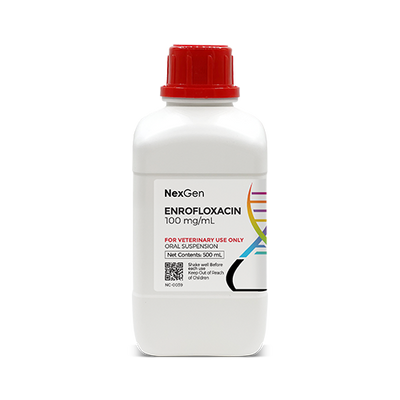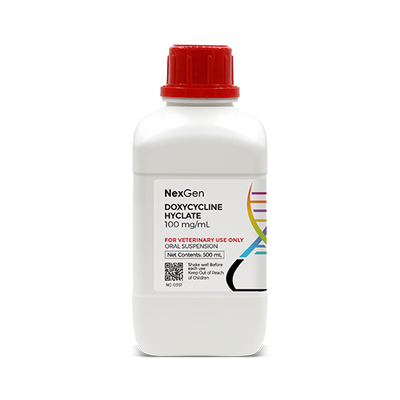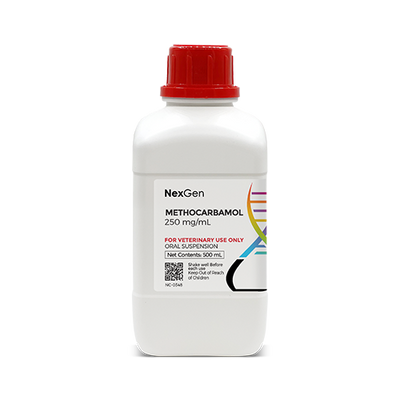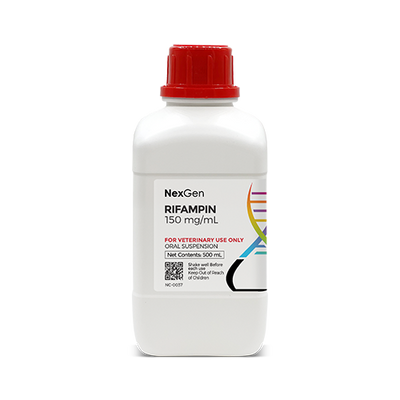
Metronidazole (as Benzoate) 100 mg/mL, Oral Suspension, (500mL)
Login for pricing
- Brand
- Mixlab
- SKU:
- NC-0456
- Product Type:
- Suspension
- Size:
- 500ml
- Administration:
- Oral
There are numerous bacterial and parasitic infestations that can cause problems in both companion animals such as dogs, and large animals such as horses. There is some interspecies crossover as regards some of the common bacterial and parasitic organisms veterinarians typically encounter, as well as treatment modalities.
Giardiasis is a chronic intestinal infection in humans and animals that is caused by the microscopic protozoan parasite Giardia duodenalis.1 This infection is simply known as Giardia. It is common in dogs, and actually occurs more frequently in humans than many are aware. The parasite is widespread in fresh water sources around the globe; thus, it is often the cause of "Traveler's Diarrhea" in human travelers and campers.2
Giardiasis in the Dog
Giardia, as an organism, exists in two discrete forms: The feeding form (trophozoite) lives in the gut of infected animals or humans, whereas the more robust form (cystic) form is shed in the feces of infected animals or humans.1,2 These can survive for months in the environment, especially in water and damp environments. Interestingly, Giardia does not always cause diarrhea; in fact, the majority of dogs infected with this parasite do not present with diarrhea, vomiting, or any other definitive signs of illness. Other examples of commonly-encountered protozoan parasites that can cause intestinal disease are Coccidia, Cryptosporidia and Toxoplasma.
Dog are infected with Giardia when they swallow the cystic stage of the G. duodenalis parasite. The cyst passes into the dog's intestines, where it undergoes transformation to the trophozoite and attaches to the intestinal wall to feed. If there are sufficient numbers of these present, clinical signs of damage to the intestinal wall will develop.2 Dogs also pass infectious cysts in their stool, where they are immediately able to infect another animal.
In dogs, Giardia can lead to weight loss and chronic intermittent diarrhea. Stools may range from soft to watery, often with a greenish tinge, and occasionally containing blood. Infected dogs will often have excess mucus in the feces. Vomiting may occur in rare cases.1
Anaerobic Bacteria and Disease in the Horse
According to the available literature, anaerobic bacteria are significant and overlooked pathogens of the lower respiratory tract in horses.3 They are also a common cause of equine endometritis in mares.4 In equine medicine, the term bronchopneumonia is used to reference infections in the lower respiratory tract regardless of whether the infection is localized to the bronchi or involves both the bronchi and the lung parenchyma. When such an infection extends from the pulmonary parenchyma to the visceral pleura and pleural space, the disease is referred to as pleuropneumonia.5 Clinical signs of bronchopneumonia are widely varied and reflect the severity of the condition. “Early identification of affected animals and immediate initiation of appropriate therapy are essential to prevent mortality and functional impairment of the respiratory system.”5
It is believed that horses typically contract bacterial pneumonia via aspiration of microorganisms that normally inhabit their nasopharynx or oral cavity, with a-hemolytic streptococci (particularly Streptococcus equi subspecies zooepidemicus) being the most common bacterial pathogens isolated from adult horses with bronchopneumonia.3 Non-enteric gram-negative bacteria such as Pasteurella spp and Actinobacillus spp are also frequently seen, occasionally in combination with S. zooepidemicus. Enteric gram-negative bacteria such as Klebsiella spp, Escherichia coli, Enterobacter spp, and Salmonella enterica may also be isolated.5
Anaerobic bacteria are isolated from approximately one third of adult horses with severe bronchopneumonia, pleuropneumonia, or pulmonary abscessation.3 The most common anaerobes isolated are Bacteroides ssp, particularly B fragilis, Clostridium ssp, and Peptostreptococcus ssp; Fusobacterium spp, and Eubacterium ssp may also be isolated. Isolation of anaerobes from horses with pneumonia or pleuropneumonia has been associated with a less favorable prognosis in some studies.5 “Mixed bacterial infections are very common and may represent synergy between aerobic or facultative aerobic and anaerobic bacteria.”3
Equine Endometritis in the Mare
Endometritis, often called an invisible disease, attacks the endometrium (uterine lining) in the mare. This in turn becomes inflamed, thus creating a hostile environment for the stallion’s and any resulting embryo. As a result, the only clinical sign of endometritis typically seen is a mare who can’t seem to get pregnant. Endometritis is a major cause of female infertility, affecting up to 15% of broodmares.4 Because it frequently lacks clear clinical signs however, it often goes undiagnosed.
Initially, endometritis is usually a normal physiological inflammatory reaction to breeding involving mechanical and immunological responses activated to rid the uterus of semen and bacteria. In most cases, the mare‘s uterus provides a hospitable environment for the development of the conceptus. However, if the mare’s immune system fails to resolve this inflammatory response within 48 hours of breeding, she will become susceptible to persistent breeding-induced endometritis (PBIE) which will have detrimental effects on her fertility.8 This predisposes the mare to bacterial or fungal endometritis leading to further degeneration of the endometrium.4
The literature describes several diagnostic methods for diagnosing endometritis, which are divided into two areas:
- Clinical examination including transrectal palpation and ultrasonography, and
- Sampling of the uterus via biopsy, swab, cytobrush, or low-volume lavage.4,8
While an accumulation of intrauterine fluid (IUF) can be detected reliably via ultrasonography, enabling the veterinarian to diagnose acute endometritis, the underlying cause for IUF cannot be determined with certainty via this method. Therefore, sampling techniques in conjunction with bacteriological, cytological and histological examinations are necessary.
Chronic infectious endometritis (CIE) as well as PBIE treatment involves uterine lavages, administration of immunomodulatory agents and ecbolics such as oxytocin. Although the usage of non-irritant solutions like saline or lactated Ringer's solution (LRS) is promoted extensively by equine veterinarians, irritant solutions such as povidone iodide solution or kerosene are also used. In cases of diagnosed CIE, antimicrobials are employed. These are administered either systemically or via intrauterine instillation.8
It has been reported that successful treatment of PBIE and CIE can result in pregnancy rates as high as those of healthy broodmares.4
Antibiotics are used to treat many infections of the equine reproductive tract, including infectious endometritis, placentitis, metritis and retained placenta in the mare and seminal vesiculitis, epididymitis and orchitis in the stallion.4,8 Antibiotics may be infused locally or administered parentally. Treatment modalities are typically based on the clinical experience of the clinician. Veterinarians have a responsibility to use antibacterial agents with due care and with appropriate recognition of the wider implications of efficacy and resistance.
Intrauterine (i.u.) infusions are administered with sterile equipment and proper aseptic preparation of the mare, with catheters being passed through the cervix and into the uterine lumen via a speculum or manually to ensure maximal cleanliness. Uterine size (determined via palpation and ultrasonographic examination) is used to estimate the volume of antibiotic solution to be instilled. Here, the objective is to use sufficient volume to achieve uniform distribution in the uterus without excessive backflow through the cervix.8
Metronidazole
Metronidazole is a systemic antibiotic and antiparasitic that is sold under the brand name Flagyl®. Available in oral and injectable forms, it is prohibited by the U.S. Food and Drug Administration (FDA) for use in food animals.
Where to buy Metronidazole
Metronidazole is available in the U.S. through several pharmaceutical manufacturers and through veterinary custom compounding companies. METRONIDAZOLE 100MG/ML Suspension by NexGen Pharmaceuticals is especially effective against anaerobic bacterial infections and as an antiprotozoal agent for both small and large animals.
Please consult your veterinarian prior to beginning any treatment regimen.
FOR RX ONLY: A valid prescription from a licensed veterinarian is required for dispensing this medication.
1Ghasemzadeh, I, and S H Namazi. Review of bacterial and viral zoonotic infections transmitted by dogs. Journal of medicine and life vol. 8,Spec Iss 4 (2015): 1-5.
2Merck Veterinary Manual.
3Sweeney CR, Divers TJ, Benson CE. Anaerobic bacteria in 21 horses with pleuropneumonia. J Am Vet Med Assoc. 1985 Oct 1;187(7):721-4. PMID: 4055490.
4Ricketts SW, Mackintosh ME. Role of anaerobic bacteria in equine endometritis. J Reprod Fertil Suppl. 1987;35:343-51. PMID: 3479588.
5Giguère, S. Bacterial Pneumonia and Pleuropneumonia in Adult Horses. In: NAVC 2012 Large Animal Conference.
7Wilson BT, Strong A, O'Kelly S, Munkley J, Stark Z. Metronidazole Toxicity in Cockayne Syndrome: A Case Series. Pediatrics. 2015 Sep;136(3):e706-8. doi: 10.1542/peds.2015-0531. PMID: 26304821.
8Morris, L., et. al. Equine endometritis: a review of challenges and new approaches. In: Reproduction, Volume 160: Issue 5, R95–R110, Nov. 2020.




















